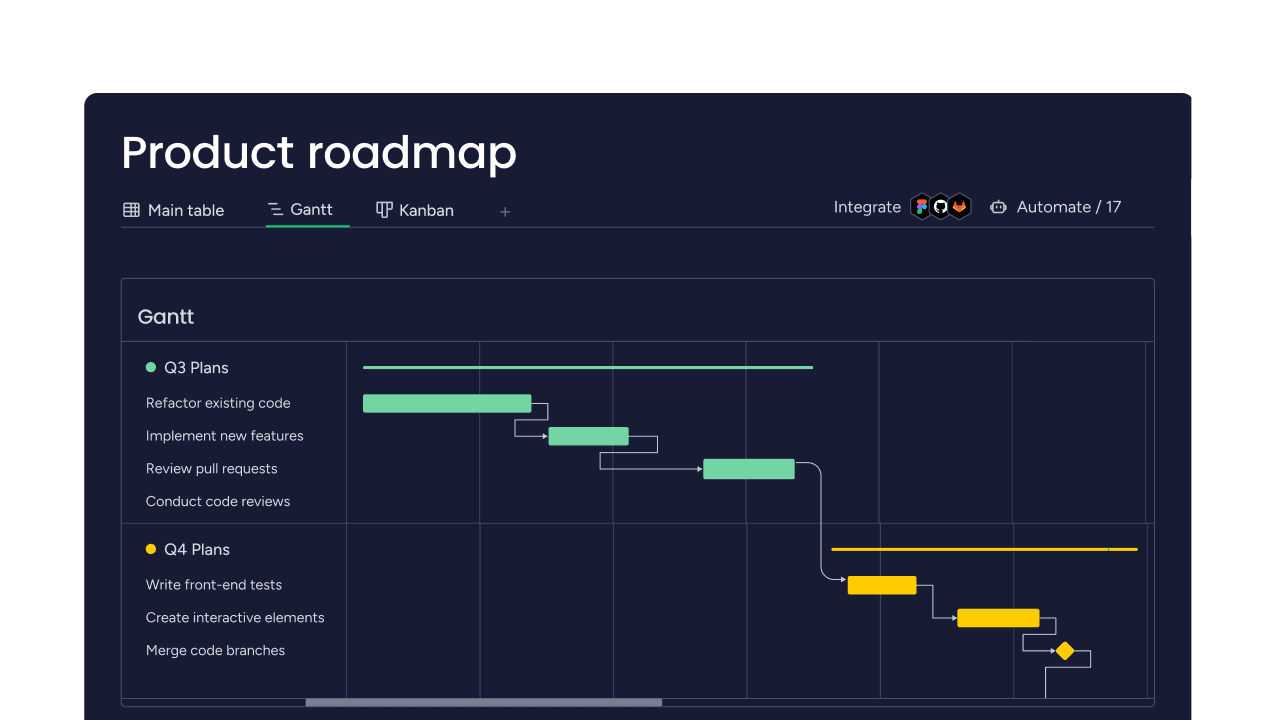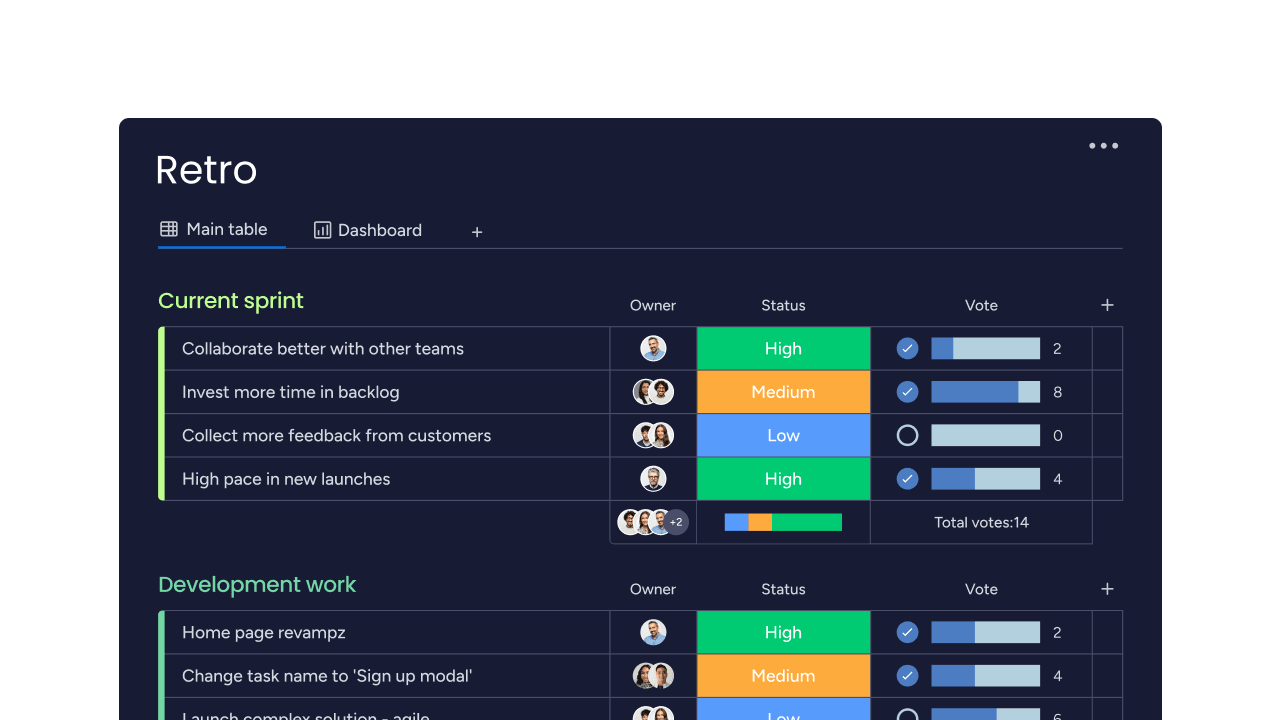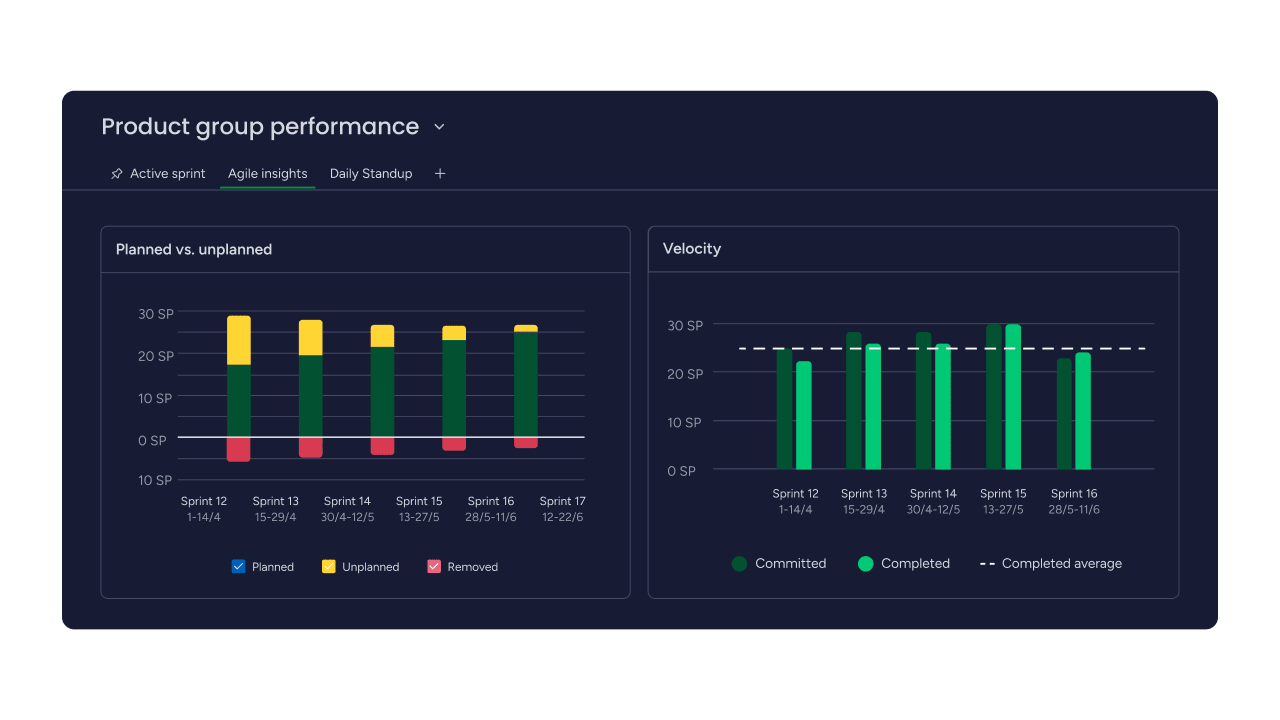In a perfect world, everything would always go according to plan.
But development teams and project managers know how quickly story points, sprints, and launch dates can slip when there’s no clear way to coordinate releases. Agile release planning brings structure to that chaos by turning your roadmap into realistic, incremental releases that keep customers and stakeholders aligned.
This guide is for product managers, R&D leaders, and development teams who want a practical overview of Agile release planning — what it is, how to build a release plan step by step, proven best practices and examples, and how to manage every release, from roadmap through launch, in monday dev.
Try monday devKey takeaways
- Agile release planning turns high-level product vision and roadmaps into realistic, incremental releases that align sprints, teams, and stakeholders around shared outcomes.
- A strong release plan combines clear goals, a prioritized backlog, data-driven capacity assumptions, and explicit risks and dependencies, refined through a simple 6-step planning process.
- Effective Agile release management favors flexible target windows, outcome-based releases, continuous customer feedback loops, and cross-functional collaboration over rigid schedules and feature lists.
- Teams improve release success by tackling common challenges head-on and tracking key metrics like release frequency, lead time, predictability, quality, and customer impact.
- With monday dev, product and engineering teams can manage the full lifecycle — from roadmap and backlog through sprints, releases, and incidents — with real-time visibility and AI that supports smarter Agile planning and execution.
What is Agile release planning?
Agile release planning is a product management approach within Agile methodology in which teams map out a series of incremental product releases rather than a single big-bang launch. It sits between your high-level product roadmap and day-to-day sprint planning, translating long-term vision into a sequence of shippable outcomes.

In practice, Agile release planning connects your product vision, roadmap, and prioritized backlog to concrete release goals, grouping user stories and features into iterations that deliver value step by step while staying flexible as requirements evolve.
Why Agile release planning matters
In short: Agile release planning matters because it accelerates product delivery.
Agile release planning exists to keep your product moving in the right direction, with logical, phased releases that teams can actually deliver. By grouping sprints into coherent releases, it aligns teams around shared outcomes, surfaces risks early, and prevents overcommitting to unrealistic timelines.
For engineering and product leaders, effective release planning delivers predictability, builds stakeholder confidence through clear forecasts, and focuses the team on customer impact rather than just shipping features. When releases consistently hit their goals, it becomes easier to communicate progress, manage expectations, and shorten time-to-market without sacrificing quality.
How Agile release planning works in Scrum
In Scrum, Agile release planning bridges your product roadmap to the increments delivered in each sprint. Instead of treating releases as one-off big events, Scrum teams use it to sequence several sprints toward a shared outcome while leaving room to adapt as they learn.
When does release planning happen in Scrum?
Release planning typically happens before a series of sprints, when a team wants to turn a product goal into a realistic sequence of releases and milestones. Many teams also revisit the release plan at major checkpoints such as the end of a sprint, at quarterly planning, or when joining a larger Agile Release Train or PI planning event in scaled environments.
Who is responsible for release planning in Scrum?
Release planning in Scrum is a collaborative effort involving the entire Scrum team and key stakeholders. The product owner leads on what to release and why, the developers estimate and plan how work fits into sprints, and the Scrum master facilitates the process and removes impediments, often incorporating input from business stakeholders who understand market needs and constraints.
What happens in an Agile release planning meeting?
An Agile release planning meeting focuses on turning product goals into a concrete plan for one or more upcoming releases. The team reviews the product vision and release goals, refines and prioritizes the backlog, checks capacity and historical velocity, maps items to sprints, and identifies key risks, dependencies, and dates so everyone leaves with a shared, realistic delivery plan.
Agile release planning vs. sprint planning: Key differences
Agile release planning and sprint planning work together, but they operate on different levels of granularity.
| Aspect | Release planning | Sprint planning |
|---|---|---|
| Time horizon | Looks across multiple sprints toward one or more releases (weeks to months). | Focuses on the upcoming sprint only (usually 1–4 weeks). |
| Main question | “When and in what grouping will we deliver this set of features or outcomes?” | “What can we commit to delivering in this sprint, and how will we do it?” |
| Scope | Groups epics and stories into releases aligned to product goals. | Breaks selected stories into tasks and a concrete sprint goal. |
| Level of detail | Higher level: goals, themes, and rough timing across sprints. | Detailed: specific items, tasks, owners, and estimates. |
| Owners | Led by product management with the Scrum team and stakeholders. | Led by the Scrum team (product owner and developers) for the next sprint. |
| Outcome | A roadmap of planned releases with target windows and scope. | A sprint backlog and a clear sprint goal the team commits to. |
When release planning is done well, sprint planning becomes much easier because the team already has clear release goals, priorities, and constraints. Instead of debating direction every sprint, teams can focus on slicing the next chunk of value, resolving dependencies, and adjusting to new information while still steering toward the agreed release outcomes.
Core components of a successful Agile release plan
A strong Agile release plan covers more than just dates and features — it gives teams a shared blueprint for how they’ll turn ideas into incremental, shippable value.
- Product vision: A clear, shared understanding of the product direction and why this release matters in the bigger picture.
- Release goals: Specific outcomes you want this release to achieve, such as improving a key workflow, launching a new capability, or moving a metric.
- Prioritized backlog: A ranked list of epics, user stories, and fixes that feed the release, ordered by customer and business value.
- Timeline and milestones: A realistic view of expected releases, including target windows and key checkpoints, not just a single date.
- Capacity and velocity assumptions: Data-driven expectations of how much work the team can complete per sprint, considering availability and historical velocity.
- Risks and dependencies: Known risks, cross-team dependencies, and assumptions that could impact scope or timing, plus how you plan to address them.
6 steps to create your Agile release plan
An Agile release plan is easier to build when you follow a simple, repeatable process that takes you from big-picture vision down to concrete sprints and dates.
1. Align on your product vision and roadmap
Start by revisiting your product vision, strategy, and high-level roadmap so everyone understands the product direction and which outcomes matter most in the next few months. This gives release planning a clear direction instead of just shuffling backlog items.

2. Set clear release goals
Translate that vision into 1–3 concrete goals for the release, such as solving a specific customer problem or launching a meaningful set of features. A good release goal describes the value you want users to experience, not just the features you want to ship.
3. Review and prioritize your backlog
Refine your product backlog to reflect those release goals, adding new items where needed and ranking Agile epics and stories by value and urgency. At this stage, many teams outline a draft release plan or roadmap that links prioritized stories to the release goal.
4. Estimate capacity and slice work into sprints
Use historical velocity and current team availability to estimate how much work you can complete per sprint, then group backlog items into a sequence of sprints that support the release goal. Keep sprints small and realistic, leaving slack for bugs, support, and learning along the way.
5. Validate the plan with stakeholders
Bring product, engineering, design, and key business stakeholders together to review the proposed release timeline, scope, and assumptions. Use this session to confirm priorities, surface risks and dependencies, and agree on what “success” looks like for the release.
6. Make the release plan visible and revisit often
Turn the plan into a living artifact that the whole team can see and update as things change. For example, you can use monday dev boards, timelines, and dashboards to track epics, sprints, and release progress in one place and adjust scope or dates based on real velocity and feedback.
Agile release planning example: A 4-sprint feature launch
Here’s a quick example of Agile release planning for a 4-sprint feature launch:
Product vision: Improve onboarding completion for new users by reducing setup friction.
Release goal: Launch a guided onboarding flow that increases first-week activation by 15%.
Release scope (4 sprints):
-
Sprint 1: Research findings, onboarding flow design, backend data model updates
-
Sprint 2: Core guided steps, in-app prompts, and basic analytics tracking
-
Sprint 3: Edge cases, performance tuning, and internal QA
-
Sprint 4: Final UX polish, documentation, and production rollout
What ships when: Instead of waiting for all work to be “done,” the team releases a usable onboarding flow at the end of Sprint 3 and uses Sprint 4 to refine based on early feedback.
Why this works: The release plan sets a clear outcome, groups sprints around value, leaves room for learning, and avoids overcommitting to a single hard launch date.
You can think of a release plan as a rolling horizon: Near-term sprints are planned in detail, while later sprints remain flexible placeholders that adjust as teams learn.
Agile release management best practices
Successful Agile release management is less about rigid schedules and more about creating a consistent way to plan, ship, and learn from every release.
Treat dates as targets, not promises
Use target windows instead of hard dates, especially beyond the next sprint, so the team can respond to new information without cutting corners on quality. Keep near-term commitments firmer and mid–long-term plans more flexible so you can adjust scope and priorities as needed.
Anchor releases around outcomes, not features
Frame each release around the customer or business outcomes you want to achieve, such as faster onboarding or higher adoption, then choose the minimum set of changes needed to get there. This keeps conversations focused on value and impact rather than debating individual tickets.
Build continuous customer feedback into every release
Collect feedback through experiments, in-app surveys, interviews, and product analytics as soon as new functionality reaches users. Feed those learnings directly back into your backlog and future release plans so each iteration moves you closer to what customers actually need.
Make release planning a cross-functional habit
Involve product, engineering, design, marketing, support, and other relevant teams early so release plans reflect real constraints and launch needs. Use shared tools and dashboards, like the release boards and status views in monday dev, to keep everyone aligned on scope, timing, and risks as plans evolve.

5 common release planning challenges — and how to solve them
Even the best-designed Agile release plans run into real-world obstacles that can derail timelines and outcomes without intentional management. Here’s how to tackle 5 common challenges.
1. Shifting priorities and scope changes
As new requests and ideas come in, releases can quickly become overloaded or lose focus.
- Solution: Define a simple intake and triage process for change, compare new requests against release goals, and explicitly trade scope, dates, or quality instead of silently overcommitting.
2. Cross-team dependencies and bottlenecks
Dependencies between teams, systems, or vendors often delay critical work.
- Solution: Map dependencies early, visualize them on your release board, and assign clear owners; where possible, form more cross-functional teams and add buffers around high-risk dependencies.
3. Estimation and capacity accuracy
Teams frequently underestimate complex work or ignore real capacity constraints.
- Solution: Use relative estimation, track planned vs actual over several sprints, and base release plans on empirical velocity rather than wishful thinking, adjusting scope as new data comes in.
4. Stakeholder pressure and fixed deadlines
Fixed dates from customers, events, or leadership can push teams toward unrealistic commitments.
- Solution: Treat dates as fixed but scope as flexible, communicate trade-offs clearly, and keep stakeholders aligned with regular, visual updates on progress and risks.
5. Scaling release planning across multiple teams or products
As more teams and products get involved, aligning roadmaps and dependencies becomes harder.
- Solution: Use a regular, shared planning cadence (for example, quarterly planning or PI-style events), standardize how teams represent releases, and roll up data into portfolio views so leaders can see cross-team progress and constraints.
Key metrics for Agile release success
Tracking the right metrics helps teams see whether releases are actually improving speed, predictability, and customer impact. Here are 5 essential metrics to track.
- Release frequency: Measures how often you successfully ship value to production (for example, releases per month or per quarter). A higher, sustainable release frequency usually indicates smoother delivery pipelines and more opportunities to learn from customers.
- Lead time: Captures how long it takes for work to move from idea or “ready” to running in production. Shorter lead times mean you can respond faster to feedback and reduce the risk of significant, last-minute changes.
- Predictability: Looks at how closely each release (or sprint) matches what the team planned to deliver, sometimes expressed as a planned-to-done ratio. Consistently high predictability builds trust with stakeholders and makes future release forecasts more reliable.

- Quality: Tracks the number of defects or incidents discovered in production after a release, and how severe they are. A downward trend in escaped defects and incidents suggests your testing, automation, and release processes are protecting users from regressions.
- Outcome: Measures whether users are getting value from what you ship, using signals such as feature adoption, usage, and NPS sentiment scores. Tying these metrics back to specific releases helps product and engineering leaders see which changes truly move the needle for customers.
Transform your Agile release process with monday dev
Built on monday.com WorkOS, monday dev manages the entire product lifecycle in one place, so your release plans stay connected from roadmaps through delivery and ongoing maintenance. Instead of juggling separate tools for ideas, sprints, releases, and incidents, teams can plan, execute, and track every release on a single, flexible platform.
Connect roadmap, epics, sprints, and releases
With monday dev, product and engineering teams can map epics on a roadmap, break them into sprints on task boards, and track progress on release and performance dashboards. Backlogs, sprint boards, and incident or bug queues all live in connected workflows, so every release shows the whole picture — from planned scope to what actually shipped and how it’s performing in production.
Give leaders real-time visibility
Development leaders and business stakeholders gain real-time visibility into release status, risks, and capacity through hierarchy views and portfolio-level dashboards. They can see how individual sprints roll up into releases, how those releases map to strategic goals, and where bottlenecks might delay delivery, without needing manual status reports.
Use AI to plan and improve releases
AI capabilities in monday dev help teams make smarter release decisions by analyzing historical work, patterns, and performance. AI can assist with prioritization, flag risks and bottlenecks, forecast velocity for upcoming sprints, and generate sprint or release summaries that capture key outcomes for stakeholders.
Try monday devBringing Agile release planning to life
Agile release planning gives your team a structured, flexible way to ship value faster — aligning on clear outcomes, adapting plans as priorities shift, and learning from every release through real metrics and customer feedback.
When you combine best practices like flexible targets, cross-functional collaboration, and outcome-focused planning with the right metrics, it becomes much easier to forecast realistically and keep stakeholders confident in your roadmap.
With monday dev, you can bring all of this together in one place — connecting your roadmap, backlog, sprints, releases, and incidents with real-time visibility and AI that works for you. Plan your next Agile release in monday dev and see how much smoother delivery can be.
Try monday devFAQs
How often should Agile teams conduct release planning?
Most Agile teams run a structured release planning session every few months, often aligned with a quarter, program increment, or major milestone. Between those cycles, they revisit the release plan in lighter-touch check-ins after sprint reviews or when significant new information or priorities emerge.
Can release planning work with fixed deadlines?
Yes, Agile teams can work with fixed deadlines by treating the date as fixed and keeping scope flexible. The release plan focuses on delivering the most valuable items before the deadline, using techniques like rolling-wave planning and capacity buffers to manage risk instead of locking everything up front.
What's the difference between a release plan and a product roadmap?
A product roadmap is a high-level, long-term view of where the product is headed and why, usually spanning quarters or years. A release plan is more tactical: it details which features or stories will ship in a specific release window, with shorter timeframes and more precise dates and owners.
How many sprints should a typical release include?
There’s no fixed rule, but many teams plan releases that span roughly 2-6 sprints, depending on cadence, complexity, and risk. Some teams release after nearly every sprint, while others group several sprints into a larger launch — the key is choosing a cadence that balances feedback and coordination costs.
Who should participate in release planning meetings?
Release planning works best when the whole Scrum or Agile team is involved, including the product owner, developers, and Scrum master or equivalent facilitator. Invite key stakeholders, such as design, marketing, support, or sales, when you need their input on priorities, dependencies, or launch activities.
How do you adjust release plans when priorities change?
When priorities change, revisit the release goals, then re-rank backlog items and adjust scope, dates, or both in a transparent way. Many teams maintain a “next up” list of candidate items and use a shared tool like monday dev to update boards and dashboards so everyone can see what changed and why.
Don’t miss more quality content!

